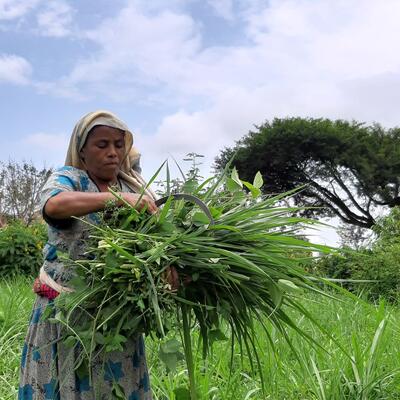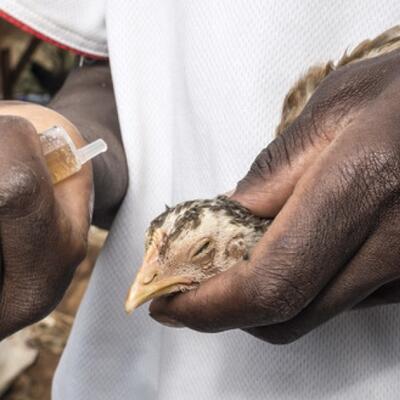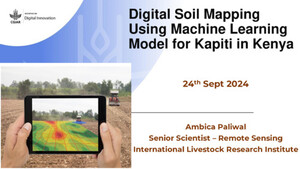
Unravelling value chains through participatory modelling
This blog is the first of a three-part series as Karl Rich, principal scientist in foresight modeling and policy at the International Livestock Research Institute (ILRI), gives us insights revolving around the system dynamics modelling technique and its usage at ILRI.
 Explaining the research process during a Spatial Group Model Building (SGMB) workshop for the pig value chain project in Myeik, Myanmar (photo credits: Lincoln University/Jared Berends).
Explaining the research process during a Spatial Group Model Building (SGMB) workshop for the pig value chain project in Myeik, Myanmar (photo credits: Lincoln University/Jared Berends).
Value chains are inherently complex. This is attributed to their dynamic nature coupled with the many players, processes and factors that are involved in different value chains. A value chain refers to ‘the full range of activities which are required to bring a product or service from conception, through the intermediary phases of production, delivery to final consumers, and its final disposal after use.’
This attribute of value chain complexity has bedeviled researchers and practitioners seeking robust analysis that provides strong justification for proposed interventions to donors. Current analytical methods, most of which are qualitative or descriptive in nature, have not been up to the task.
System dynamics (SD) models offer one possible solution. They are a family of methodologies based around the broader field of systems thinking, which views the world’s social and natural systems as an interconnected collection of stocks, flows and feedbacks. SD approaches embrace complexity and provide users with a language and opportunity to understand how complex systems like value chains evolve over time.
Within CGIAR, ILRI has pioneered the use of SD models in the context of agri-food and livestock value chains. Karl Rich, a principal scientist at ILRI, notes that ILRI’s interest in SD is ‘motivated by the need to address the multi-faceted interactions and feedbacks that exist between the biology of animal production, market dynamics and epidemiology of animal diseases, institutions and land-use patterns—all of which influence the impact and uptake of market, policy and technical interventions’.
ILRI’s SD-based models of livestock
value chains test scenarios that measure the predicted (ex-ante) returns
of different interventions. Through the use of SD models, a broader analysis of
ex-ante returns is possible,
exploring unintended consequences and long-term effects as well as pinpointing the
narrow band of high-leverage interventions.
Recently, ILRI and partners have implemented participatory processes in the construction of SD models. Such techniques (termed ‘group model building’ or ‘mediated modelling’) involve the careful organization of several focus group sessions with 10-15 value chain stakeholders. The participants articulate value chain problems, structure, and data that are then used to parametrize working models from which scenarios can be jointly developed and discussed. Participatory processes have proven valuable in engaging with value chain stakeholders as they foster collaboration, team building and learning among participants. They also provide a means to obtain data in data-scarce environments by bringing together the actors from across the value chain, to discuss pertinent matters.
 Nazmun Ratna (Lincoln University, New Zealand) and Sadman Sadek (Digital Green) working with participants to build a causal-loop diagram of vegetable marketing in Jashore, Bangladesh (photo credit: SOAS/ Gregory Cooper).
Nazmun Ratna (Lincoln University, New Zealand) and Sadman Sadek (Digital Green) working with participants to build a causal-loop diagram of vegetable marketing in Jashore, Bangladesh (photo credit: SOAS/ Gregory Cooper).
ILRI has also added another innovation by incorporating spatial attributes of value chains. This helps to address the ‘where’ of value chain evolution that is largely missing from conventional analyses. This technique, termed ‘spatial group model building (SGMB), uses participatory geographic information system (GIS) methods to actively engage with stakeholders to identify value chain characteristics directly on maps. Karl notes that ‘our experience with SGMB is that people are visual and identify strongly with place. Using participatory GIS enriches our understanding of how value chains work and helps to establish a common reference point from which to start the modelling process.’
Where is it being applied?
At ILRI, participatory SD modeling
techniques are actively being used in the following projects:
- Market Intervention for Nutritional Improvement (MINI): a project funded by Bill and Melinda Gates Foundation and co-led by the University of London-SOAS and ILRI to analyze market and technical interventions in vegetable and poultry value chains in Bihar and Myanmar.
- Thanintharyi Region Rural Income and Livelihoods Development (TRRILD): a project funded by the New Zealand Ministry of Foreign Affairs and led by World Vision New Zealand to identify and implement pro-poor interventions in targeted value chains (pigs and paddy) in the townships of Myeik and Palaw in southern Myanmar.
In addition to these projects, participatory systems dynamics methods are programmed into several upcoming projects (seven of these are confirmed) that will commence over the next six to twelve months.
Brief bio
Karl M. Rich is a principal scientist in foresight modeling and policy at ILRI. He is also the co-principal investigator (PI) on the Market Intervention for Nutritional Improvement (MINI) project in India, Bangladesh and Ethiopia as well as the technical lead on value chain upgrading strategies within the Thanintharyi Region Rural Income and Livelihoods Development (TRRILD) Project in southern Myanmar. Both projects are applying participatory SD and GIS techniques.
The next two blogs will cover varied aspects of the MINI and the TRRILD projects, both of which ILRI is jointly working on.
Access related information here.
















